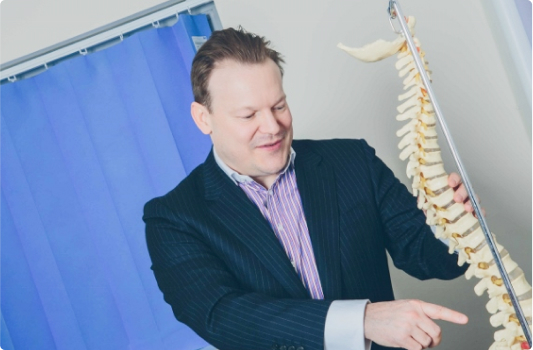Sciatica Treatment Services
At Spine Art, our experienced team specializes in providing comprehensive treatment solutions tailored to alleviate the symptoms of sciatica, including back pain and spine pain. Utilising advanced minimally invasive procedures, we aim to offer effective relief while minimising recovery times and discomfort. Whether you’re experiencing mild discomfort or severe pain, our personalised approach ensures you receive the care you need to regain mobility and improve your quality of life. Take the first step towards relief and schedule a consultation with our expert team.
What Is Sciatica?
Sciatica refers to a condition characterised by pain that radiates along the path of the sciatic nerve, which stretches along the lower back through the hips and down each leg. Usually, sciatica affects just one side of your body and can range from a mild ache to excruciating pain. While sciatica can be incredibly uncomfortable, the good news is that many cases can be effectively managed with conservative treatments such as rest, gentle exercises, physical therapy, and medication. In more severe cases, minimally invasive procedures or surgery may be necessary to alleviate pressure on the affected nerve roots.
Book a consultation
Symptoms of Sciatica
Sciatica can manifest through various symptoms, indicating compression or irritation of the sciatic nerve roots. These symptoms often include:
- Radiating Pain – Characterised by sharp, shooting pain that travels from the lower back or buttocks down the leg, following the path of the sciatic nerve. This pain can be debilitating and may worsen with movement.
- Numbness – Individuals with sciatica may experience numbness or a loss of sensation in the affected leg or foot. This sensation can range from mild to severe and may be accompanied by tingling or a “pins and needles” feeling.
- Tingling – A common symptom of sciatica is a tingling sensation that radiates along the path of the sciatic nerve. This sensation may be intermittent or constant and can vary in intensity.
- Weakness – Sciatica can lead to weakness in the affected leg or foot, making it difficult to walk, stand, or perform daily activities. This weakness may be accompanied by a feeling of instability or difficulty supporting weight.
Causes of Sciatica
Sciatica can arise from various underlying conditions that affect the spine and surrounding structures, leading to compression or irritation of the sciatic nerve roots. According to our expert team, these causes include:
- Herniated Discs – When the soft inner material of a spinal disc extends through its tough outer shell, it can press on nearby nerve roots, which make up the sciatic nerve, causing pain and discomfort.
- Spinal Stenosis – This condition involves the narrowing of the spinal canal, which can exert pressure on the spinal cord or nerve roots, leading to symptoms such as pain, numbness, weakness, or loss of balance.
- Degenerative Disc Disease – Over time, the spinal discs may degenerate, losing their water content, resistance to compression under load, and height, which can result in disc bulging or protrusion and subsequently compress the sciatic nerve roots causing inflammation of those neural structures.
- Muscular Imbalances – Imbalances in the muscles surrounding the spine can lead to abnormal pressure and stress on the structures of the lower back, becoming inflamed and triggering symptoms of referred pain (pain felt in the leg like sciatica).
How Sciatica Is Diagnosed
Diagnosing sciatica typically involves a comprehensive approach that includes a thorough medical history assessment, physical examination, and diagnostic imaging studies. During the medical history assessment, our surgeon will inquire about the onset, duration, and characteristics of the symptoms, as well as any previous injuries or medical conditions that may be contributing factors. A physical examination may involve various maneuvers to assess range of motion, muscle strength, and sensation in the affected areas. Additionally, diagnostic imaging studies such as MRI (Magnetic Resonance Imaging), CT scan (Computed Tomography), or X-rays may be ordered to visualise the spine and surrounding structures in detail. These imaging studies help identify underlying causes of sciatica, such as herniated discs (disc protrusions), spinal stenosis, or degenerative changes.
Non-Surgical & Surgical Treatment Options
When it comes to treating sciatica, various options are available to alleviate pain and improve function. Non-surgical treatments may include:
- Medication – Over-the-counter or prescription medications, such as nonsteroidal anti-inflammatory drugs (NSAIDs) or neural modulators, can help manage pain and reduce inflammation associated with sciatica.
- Physical Therapy – Targeted exercises and stretches prescribed by a physical therapist can strengthen spinal and core muscles, improve stability, and alleviate pressure on the sciatic nerve roots by offloading biomechanical forces through the affected disc.
- Chiropractic Care – Spinal adjustments performed by a chiropractor may help realign the spine, offload painful motion segments and reduce symptoms of back and referred pain. This modality should be used cautiously in the presence of a slipped disc or disc protrusion causing sciatica.
- Acupuncture – This ancient practice involves inserting thin needles into certain points on the body to promote pain relief, potentially providing relief from sciatica symptoms.
- Foraminal Epidural Steroid Injections – Targeted (image guided) injections of corticosteroid (Kenalog) in combination with long-acting local anaesthetic into the epidural space around specific spinal nerve roots can help reduce inflammation and alleviate pain associated with sciatica. This very simple and effective treatment provides permanent relief in 70% of cases!

In cases where non-surgical treatments fail to provide sufficient relief, minimally invasive procedures or surgical interventions may be considered:
- Percutaneous Discectomy – A truly minimally invasive and transformational procedure with an 80% success rate and low complication rate. Access is gained to the problem disc with a small diameter portal placed under image guidance within the spine. Through this, a thin wand is inserted which generates a high energy plasma field. This is used to vapourise the disc protrusion and decompress the disc and relieve pressure on the nerve roots. This is all achieved without having to make an incision or opening in the body and is done as a day case.
- Microdiscectomy – An open surgical procedure performed to remove a portion of a herniated disc that is pressing on the sciatic nerve roots, relieving pain and restoring function.
- Spinal Decompression Surgery – This surgical intervention aims to alleviate pressure on the spinal nerves through a small incision by removing portions of bone or tissue that are compressing the nerve roots in the spinal canal, providing relief from symptoms of sciatica or spinal stenosis.
Contact Spine Art to Treat Your Sciatica Symptoms
Don’t let sciatica control your life any longer. At Spine Art, our commitment to excellence in care means you can trust us to provide the relief you need. Our team is dedicated to helping you find lasting relief from sciatica and other spine-related issues. Take charge of your health and schedule a consultation with us today. Let’s work together to restore your comfort, mobility, and overall well-being. Your journey to a pain-free life starts here.
What is the cost of the procedure?
SpineArt fees due at the point of booking
Foraminal Epidural
A transforaminal epidural injection is the newest type of epidural steroid injection with the highest success rate and low complication rate.
View full price list£1,020*
*Prices correct as of July 2022. Please note these are fees due to SpineArt, hospital fees will be charged separately.
Want to talk to someone or book an appointment?
If your still unsure and have any questions, contact our receptionist Bev on 07539 330360 to arrange a consultation with Dan Fagan or email us at secretary@spineart.org.
Get in touch Book a consultation







